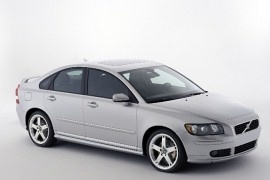
VOLVO S40
Generations Timeline, Specs and Pictures

Reaching its second generation in 2007, the S40 was an entry level luxury sedan capable to offer refinement and style.
Although not so fun-to-drive as the contemporary competitors such as the A4 or the BMW 3-Series, the S40 came with a more attractive price.
Available in two trim levels, the S40 came with a choice of two engines, a 2.4-liter unit that developed 168 hp and a 2.5-liter 5-cylinder that cranked out 218 hp. While the 2.4-liter powerplant offered decent power, it was unimpressive and not attractive compared to the more powerful 2.5-liter unit.
The base trim level came equipped with 16-inch alloys, manual climate control, power accessories and heated mirrors and was available only with a front-wheel-drive system.
Stepping up to the T5 trim level, the S40 featured the more powerful engine already mentioned, an in addition to that, it could be equipped with a four-wheel-drive system. Other standard equipments included fog lights, cabin aluminum inserts, automatic climate control, an 8-way power driver seat and a trip computer. These features could be added to the base trim level with extra costs.
Other features were bundled into packages and the S40 could be equipped with a moonroof, an upgraded audio system, leather upholstery, a sport-tuned suspension, 17-inch alloy wheels, heated seats, rain-sensing wipers, headlamps washers, bi-xenon HID headlights, keyless go and a navigation system.
It’s not surprise that the S40 was well equipped safety-wise, with Dynamic Stability and Traction control as standard, numerous airbags, anti-whiplash head restraints and seatbelts pre-tensioners.

The S40 was one of the cars that was constantly improved over time, boosting its appeal.
The classy saloon was based on the same building block as the Ford Focus, thus was good to drive.
The great handling and good grip were not the only aspects worth mentioning, as the S40 was also easy on the pocket and on the environment.
Offered with a variety of engines, the S40 was also chosen as the green car of the year due to the 1.6 Diesel engine that was equipped with a start stop system - the emissions were kept low.
Practicality wise, the S40 did not score very high. Even though it could easily accommodate 4 passengers, the rear seats legroom was limited, as well as the storage space.
Otherwise, the driver was offered great comfort with the easily adjustable seats and steering wheel, not to mention the great visibility all around.
The S40 offered a great value for money, as the base version came with alloy wheels, stability control, climate control and power windows, thus moving to upper trims was not a must.
Although the S40 had a classy look, it didn’t hold value very well, Volvo still struggling with getting rid of the “safe but boring” image created over the years.

The 2000 version of Volvo S40 was actually called the second phase of this popular vehicle which provided remarkable performances not only on regular roads, but also during racing competitions.
In 2000, the Swedish carmaker Volvo rolled out a facelift for the S40 model, a facelift which was mainly based on technical improvements. For example, the new car came with larger brake discs but also with a new front suspension system and improved rear suspension. In addition, Volvo introduced a couple of new safety features which could make the vehicle even safer than the previous model which was already praised for this kind of features.

Since the launch of the 1992 Volvo 850, it was clear that Volvo entered into a new era, where front-wheel-drive and rounded shapes replaced the rear-wheel-drive systems and the boxy bodyworks.
Volvo needed a new platform and a factory inside the EEC (Economic European Community) to avoid customs taxes. The answer came from Mitsubishi, who was looking for a partner to build its Carisma mid-size range in Europe and invest in a new front-wheel-drive platform. The Swedish and Japanese carmakers joined their forces and produced the Volvo S40/V40 and the Carisma, respectively. And that’s why the S/V40 had a 4x114.3 pattern for its wheels (PCD).
The 1996 S40 looked like no other Volvo before. At the front, the bumper featured a lower apron where the carmaker integrated the fog lights. Its horizontal headlights featured smoothed corners on the upper side, flanking the chromed grille with vertical slats. The greenhouse extended behind the rear doors, and the carmaker added a third, small side window between the rear doors and the C-pillars. A flat trunk lid with rounded corners and a set of corner-mounted taillights wearing a clear middle line completed the car’s image.
Inside, the carmaker installed a dashboard with smooth lines and a center stack that hosted the HVAC controls on the upper side and the radio cassette player at the bottom. Volvo used a green light illumination in the instrument cluster, showing the speedometer in the middle and the tachometer on the left. Its five-seat cabin offered good room for the front passengers and adequate for the rear ones.
Under the hood, the Swedish carmaker installed a wide engine choice either built by Volvo or Mitsubishi (the 1.8-liter direct-injected gasoline unit) or Renault (the 1.9-liter turbo-diesel).























































